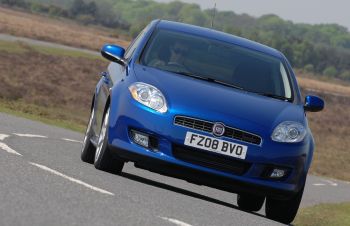

 |
|
Three new additions to Fiat’s 5-door
mid-size Bravo range – two 1.6 MultiJet
versions and an Eco option – went on sale in
the UK earlier this month. These Euro
5-compliant versions join a buoyant Bravo
line-up, which has enjoyed significant
recognition since its introduction to the UK
in June last year. |
|
|
|
Three new additions to Fiat’s 5-door mid-size Bravo
range – two 1.6 MultiJet versions and an Eco option –
went on sale in the UK earlier this month. These Euro
5-compliant versions join a buoyant Bravo line-up, which
has enjoyed significant recognition since its
introduction to the UK in June last year.
The 2007 launch marked Fiat’s return to the second largest
segment of the UK market, which equates to almost 600,000
cars per year or some 25 per cent of the total. The new
engines enhance existing aspects of the Bravo range – with
even more impressive economy, lower running costs and
notably low emissions.
There are now 17 versions in the UK Bravo range, priced from
£10,995 to £16,355 on-the-road, embracing five trim levels –
Bravo, Active, Active Sport, Dynamic and Sport. Augmenting
an interior design founded on the fundamental pre-requisites
of class-leading space, exemplary build quality, and visual
and tactile sophistication, the Bravo’s equipment
specification has been carefully considered to simplify and
enhance life on board. ABS anti-lock braking, remote central
locking, driver and passenger front and side airbags,
electric front windows, a CD player, Dualdrive electric
power steering and Follow Me Home headlamps are fitted as
standard, even within entry level models.
This comprehensive equipment package is further boosted by a
range of innovative, safety and comfort enhancing options
such as dual-zone climate control, cruise control, rain,
parking and tyre pressure sensors, a SkyDome glass sunroof
occupying almost the entire Bravo roof area, a CD system –
with subwoofer – that can play MP3 files, and Blue & Me
mobile phone and MP3 player connectivity with steering wheel
controls.
The new 1.6 MultiJet engine brings the number of powerplants
offered in Bravo’s UK range to six. The 1.6 has four
cylinders in line, 16 valves, and a displacement of 1598
cc. Two different engines are available: the first
developing 105 bhp at 4000 rpm and torque of 290 Nm (214 lb
ft) at 2000 rpm; the second developing 120 bhp at 4000 rpm
and torque of 300 Nm (221 lb ft) at 2000 rpm. Both units
come with a manual six-speed gearbox which generates
significantly less noise at motorway speeds and facilitates
reduced fuel consumption.
This new 1.6 MultiJet is also available with a special
eco-package in 105 bhp form. In addition to revised engine
ECU settings, this ‘Eco’ pack employs special measures to
optimise aerodynamics, incorporates low rolling resistance
tyres and ‘taller’ gear ratios, and returns outstanding fuel
consumption and CO2 figures: 62.8 mpg in the combined cycle
(an increase of five mpg on the standard 105 bhp 1.6
MultiJet) and CO2 emissions of just 119 g/km.
These engines are boosted by either
electronically-controlled fixed-geometry (105 bhp version)
or variable-geometry (120 bhp version) turbochargers, to
enhance power output while providing very high torque even
at low revs. The engines are best in class for maximum
torque, while specific torque output is best-in-segment for
engines below 200 bhp. Compared with the current Fiat 1.9
MultiJet 120 bhp unit, the 1.6 MultiJet series represents an
important step forward – with the same power, torque is
improved by almost 25 per cent at 1500 rpm, and fuel
consumption is reduced by eight per cent.
The Bravo engine line-up also includes the 1.4 litre T-Jet
150 bhp turbocharged petrol engine, which made its debut in
the Bravo. This is the first example of a new family of
turbocharged petrol units developed by Fiat Powertrain
Technologies to combine the sporting performance and low NVH
characteristics of a petrol engine with fuel economy
comparable to a diesel unit and CO2 emission levels which
readily comply with increasingly stringent European
regulation.
Through cubic capacity downsizing allied to the adoption of
the smallest possible turbocharger, Fiat’s responsive 150
bhp 1.4 litre T-Jet engine combines performance equal to or
better than a conventionally aspirated 1.8/2.0 litre petrol
engine, but with a reduction of between 10 and 20 per cent
in fuel consumption and emissions. These advantages are
especially useful, given the importance of the fleet market,
where taxation plays a major role. The addition to the UK
range last September of a 120 bhp version of this
outstanding unit, offers performance equal to or better than
a conventionally aspirated 1.6 litre petrol engine, with
significant fuel consumption reductions.
Fiat’s T-Jet engines are pioneers of the downsizing
philosophy which consists of a turbo compressor coupled with
a smaller, lighter engine to achieve better performance with
lower consumption and emissions. Fun to drive, the T-Jet
engine range features lower fuel consumption thanks to
higher combustion efficiency.
Bravo can also be equipped with a 90 bhp version of Fiat’s
lively 1.4 litre 16-valve Fire petrol engine, as well as a
150 bhp 16-valve version of the company’s widely acclaimed
1.9 litre Common rail direct injection MultiJet turbodiesel.
These on-going developments with Bravo fit perfectly with
Fiat’s plans to be an environmental leader among the world’s
car companies. In 2007, Fiat Group CEO Sergio Marchionne
announced his intention to push forward with plans, by 2012,
to reach the lowest weighted average CO2 emission level for
the cars Fiat produces, compared with its competitors. Fiat
is already the top performer in Europe for having the lowest
average CO2 emissions, at 137.3g/km, according to the latest
figures published by Jato Dynamics, a world leader in
automotive research and information. Widely recognised as
being one of the world’s ‘greenest’ car manufacturers, Fiat
was also recently voted the UK’s lowest CO2 emitting car
brand by CleanGreenCars.co.uk.
|